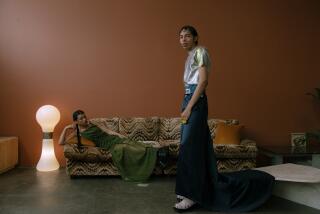Business Rests on Chair Reproductions : Hitchcock Profits From Tradition
RIVERTON, Conn. — If John Tarrant Kenney hadn’t been such an avid fisherman, the old Hitchcock Chair Co. would still be a footnote in Connecticut history.
Instead, Hitchcock Chair is very much alive, with sales this year expected to be more than $40 million, compared to $3 million 10 years ago.
The company is an anomaly, one of a handful of New England furniture makers that has not folded or moved south to the Carolinas.
Kenney, who died last year at age 71, was 33 and just out of the Marine Corps in 1946 when he came to this quaint country village in Connecticut’s northwest corner to catch some trout in the Farmington River.
He stayed at the 10-room Old Riverton Inn--called Ives’ Tavern when established in 1796--and ate in the inn’s Cat Nip Mouse Tearoom. Across the river from the inn, standing in ruins and choked with weeds, was the abandoned Hitchcock Chair Co. plant, built in 1826.
Kennedy was intrigued. The Hitchcock name rang a bell: One of his wedding gifts was an antique Hitchcock chair manufactured in that very plant.
Leland Hitchcock has sometimes been called America’s greatest chair maker. He built chairs in that factory from 1826 to 1840, when it was the biggest furniture company in the nation. After Hitchcock sold his interest, the chair company continued until 1864. Then it became a ruler factory until, after 1900, it was abandoned.
Kenney had been a successful owner of four women’s discount shoe stores before World War II. But, after he left the Marines, he was looking for a new career. Fascinated by the Hitchcock story, he bought the historic chair factory for $5,000, spent three years restoring it and then began reproducing copies of Hitchcock’s famous stencil-decorated chairs that carried the trademark “L. Hitchcock, Hitchcocks-ville, Conn. Warranted.” Often, the “Ns” in the trademark were printed backward. Today, the “Ns” in the same trademark are always stenciled backward on the company’s products.
Riverton’s original name was Hitchcocks-ville, named after Leland Hitchcock, who founded the village. But mail kept getting mixed up with that for Hotchkissville--15 miles away--so, in 1910, Hitchcocks-ville became Riverton.
Half of Hitchcock Chairs’ business today is from the sale of reproductions of Leland Hitchcock’s original-design chairs. The other half is from bedroom, living room and dining room furniture.
Annie Caine, 58, makes chair seats out of female leaves of the cattail plant, as she has for 31 years, weaving three to four seats each day using 3 pounds of rush per chair. Caine is one of five weavers doing a job that hasn’t changed since Leland Hitchcock’s time. The cattail leaves are harvested by college students in the late summer in swamps near Syracuse, N.Y.
Many of the methods of manufacturing the chairs are traditional. Beatrice Osten, 69, has been a stenciler for 25 years. That craft hasn’t changed much either.
Floors, ceilings and walls in many of the early 19th-Century homes in Riverton and surrounding towns are decorated with stenciled artwork executed by moonlighting Hitchcock stencilers.
A big boost to the success of Hitchcock Chair, said Kenney’s son-in-law, Tom Glennon, 50, president of the company for the past 10 years, has been the opening of eight Hitchcock Chair retail stores in New England.
Today, the company has three factories, two in Riverton and the main plant at New Hartford, a 125,000-square-foot, 6-year-old, $2-million state-of-the-art facility.
So popular were the original Hitchcock chairs that Hitchcock became a generic name for a style of stencil-decorated chairs.
In his day, Hitchcock’s fancy chairs sold for 45 cents to $1.75. The reproductions of those chairs sell for $100 to $300 today.
Riverton appears much as it did when Leland Hitchcock was still alive. All of the early 19th-Century houses in town are owned by Hitchcock Chair and rented out to antique dealers.
When Hitchcock proposed marriage to his wife, Eunice, and she accepted, he built a church in the village for his wedding in 1830. The Union Episcopal church is now the Hitchcock Museum, and it is filled with Leland Hitchcock memorabilia, including many examples of his original furniture.
And, each spring since 1947, the company has sponsored a major fishing derby to commemorate that day 39 1/2 years ago when Jack Kenney went fishing in the Farmington River.
More to Read
Inside the business of entertainment
The Wide Shot brings you news, analysis and insights on everything from streaming wars to production — and what it all means for the future.
You may occasionally receive promotional content from the Los Angeles Times.









